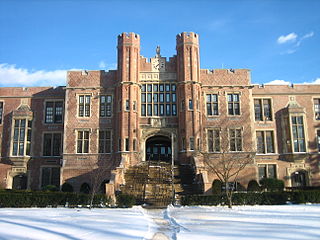
Teaneck is a township in Bergen County, in the U.S. state of New Jersey. It is a bedroom community in the New York metropolitan area. As of the 2020 United States census, the township's population was 41,246, an increase of 1,470 (+3.7%) from the 2010 census count of 39,776, which in turn reflected an increase of 516 (+1.3%) from the 39,260 counted in the 2000 census. As of 2020, Teaneck was the second-most populous among the 70 municipalities in Bergen County, behind Hackensack, which had a population of 46,030.

Fairleigh Dickinson University is a private university with its main campuses in New Jersey, located in Madison / Florham Park and in Teaneck / Hackensack. Founded in 1942, Fairleigh Dickinson University offers more than 100 degree programs. In addition to two campuses in New Jersey, the university has a campus in Vancouver, British Columbia, one in Wroxton, Oxfordshire, United Kingdom, and an online platform. Fairleigh Dickinson University is New Jersey's largest private institution of higher education, with over 12,000 students.
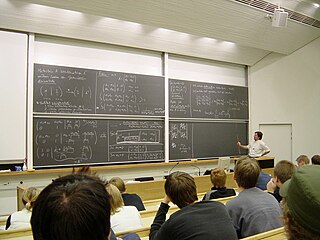
In contemporary education, mathematics education—known in Europe as the didactics or pedagogy of mathematics—is the practice of teaching, learning, and carrying out scholarly research into the transfer of mathematical knowledge.

New Mathematics or New Math was a dramatic but temporary change in the way mathematics was taught in American grade schools, and to a lesser extent in European countries and elsewhere, during the 1950s–1970s.

Toru Kumon was a Japanese mathematics educator, born in Kōchi Prefecture, Japan. He graduated from the College of Science at Osaka University with a degree in mathematics and taught high school mathematics in his home town of Osaka. In 1954, his son, Takeshi, performed poorly in a Year 2 mathematics test. Prompted by his wife, Teiko, Toru closely examined Takeshi's textbooks and believed they lacked the proper opportunity for a child to practice and master a topic. As a result, he began to handwrite worksheets each day for his son. By the time Takeshi was in Year 6, he was able to solve differential and integral calculus usually seen in the final years of high school. This was the beginning of the Kumon Method of Learning.

Teaneck High School is a four-year comprehensive public high school in Teaneck, in Bergen County, New Jersey, United States, serving students in ninth through twelfth grades as the lone secondary school of the Teaneck Public Schools. The school has been accredited by the Middle States Association of Colleges and Schools Commission on Elementary and Secondary Schools since 1935.

The Teaneck Public Schools is comprehensive community public school district serving students in pre-kindergarten through twelfth grade in Teaneck, Bergen County, in the U.S. state of New Jersey.

The Nueva School is a private school, with two campuses—the lower and middle school in Hillsborough, and the high school in San Mateo, California—serving gifted students in pre-kindergarten through twelfth grade. Nueva was founded in 1967 by Karen Stone McCown. Originally, the Nueva School only served younger students, but in 2013 it expanded to include a high school, and a new campus for it was built as part of the Bay Meadows development in San Mateo, opening in August 2014.
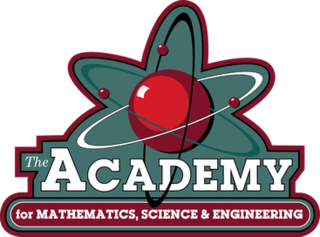
The Academy for Mathematics, Science, and Engineering (AMSE) is a four-year magnet public high school program intended to prepare students for STEM careers. Housed on the campus of Morris Hills High School in Rockaway, in the U.S. state of New Jersey, it is a joint endeavor between the Morris County Vocational School District and the Morris Hills Regional District.
Saxon math, developed by John Saxon (1923–1996), is a teaching method for incremental learning of mathematics created in the 1980s. It involves teaching a new mathematical concept every day and constantly reviewing old concepts. Early editions were deprecated for providing very few opportunities to practice the new material before plunging into a review of all previous material. Newer editions typically split the day's work evenly between practicing the new material and reviewing old material. It uses a steady review of all previous material, with a focus on students who struggle with retaining the math they previously learned. However, it has sometimes been criticized for its heavy emphasis on rote rather than conceptual learning.

Science, technology, engineering, and mathematics (STEM) is an umbrella term used to group together the distinct but related technical disciplines of science, technology, engineering, and mathematics. The term is typically used in the context of education policy or curriculum choices in schools. It has implications for workforce development, national security concerns, and immigration policy, with regard to admitting foreign students and tech workers.
A worksheet, in the word's original meaning, is a sheet of paper on which one performs work. They come in many forms, most commonly associated with children's school work assignments, tax forms, and accounting or other business environments. Software is increasingly taking over the paper-based worksheet.
A Bachelor of Economics is an academic degree awarded to students who have completed undergraduate studies in economics. Specialized economics degrees are also offered as a "tagged" BA (Econ), BS (Econ) / BSc (Econ), BCom (Econ), and BSocSc (Econ), or variants such as the "Bachelor of Economic Science".
Math wars is the debate over modern mathematics education, textbooks and curricula in the United States that was triggered by the publication in 1989 of the Curriculum and Evaluation Standards for School Mathematics by the National Council of Teachers of Mathematics (NCTM) and subsequent development and widespread adoption of a new generation of mathematics curricula inspired by these standards.
Al-Ghazaly High School in Wayne, in Passaic County, New Jersey, is one of the oldest Islamic high schools in the United States. The school was founded in 1984, and serves students in seventh through twelfth grades. The principal is Sr. Khaldiya Mustafa. Most students at Al-Ghazaly High School come from Al-Ghazaly and Al Hikmah Elementary School, located at Communipaw Avenue in Jersey City and North 8th Street in Prospect Park, respectively.
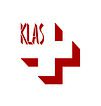
Kumon Leysin Academy of Switzerland (KLAS) is a private high school in Leysin, Switzerland, founded by the Kumon Gakuen Educational Foundation in 1990.
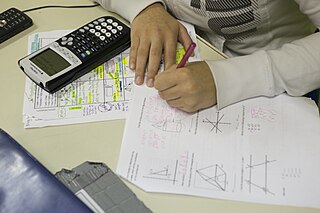
Mathematics education in the United States varies considerably from one state to the next, and even within a single state. However, with the adoption of the Common Core Standards in most states and the District of Columbia beginning in 2010, mathematics content across the country has moved into closer agreement for each grade level. The SAT, a standardized university entrance exam, has been reformed to better reflect the contents of the Common Core. However, many students take alternatives to the traditional pathways, including accelerated tracks. As of 2023, twenty-seven states require students to pass three math courses before graduation from high school, while seventeen states and the District of Columbia require four. A typical sequence of secondary-school courses in mathematics reads: Pre-Algebra, Algebra I, Geometry, Algebra II, Pre-calculus, and Calculus or Statistics. However, some students enroll in integrated programs while many complete high school without passing Calculus or Statistics. At the other end, counselors at competitive public or private high schools usually encourage talented and ambitious students to take Calculus regardless of future plans in order to increase their chances of getting admitted to a prestigious university and their parents enroll them in enrichment programs in mathematics.

Mathnasium is an American education brand and supplemental math learning franchise consisting of over 1,000 learning centers in North America, South America, Europe, the Middle East, and Asia that provides instruction to students in pre-kindergarten through high school. The curriculum employs the Mathnasium Method, a proprietary system that was developed by a team of education experts with co-founder Lawrence Martinek.

Activity-based learning, or ABL, describes a range of pedagogical approaches to teaching. Its core premises include the requirement that learning should be based on doing hands-on experiments and activities. Activity-based learning is rooted in the idea that children are active learners rather than passive recipients of information. If children are provided the opportunity to explore on their own and are provided with an optimum learning environment, then learning becomes more joyful and long-lasting.
Charis Global School is a private National Plus school in Lippo Cikarang, Bekasi City, West Java, Indonesia. Essentially, the school programs are developed into three categories: Early Childhood Program, Primary Program and Secondary Program.














